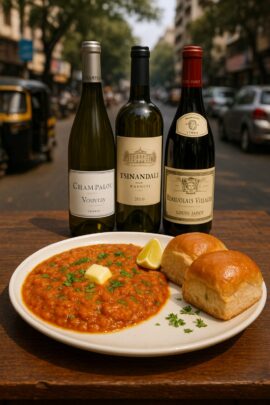Dish Name & Cultural Context
Pav Bhaji originated on the bustling streets of Mumbai in the mid-1800s as a quick lunch for textile mill workers. What began as a humble street food has now become a beloved comfort dish across India and beyond. It’s iconic for its vibrant spice, buttery texture, and versatility—served from street stalls to upscale Indian bistros.
Key Ingredients & Preparation Style
At its heart, Pav Bhaji is a spicy, mashed vegetable curry (the “bhaji”) made from potatoes, peas, cauliflower, bell peppers, and tomatoes, all cooked with butter and a special Pav Bhaji masala. It’s served piping hot with lightly buttered, griddled bread rolls (the “pav”).
Flavor & Texture Profile
- Dominant Tastes: Spicy, tangy, buttery, umami-rich
- Texture: Creamy and slightly chunky bhaji, soft and toasted pav
- Notable Flavors: Cumin, coriander, chili, turmeric, garlic, onion, and kasuri methi
Science Behind Spice & Wine Interactions
- Acidity in wine brightens the rich, buttery bhaji and balances the tangy tomato base.
- Low Tannins are essential—high tannin red wines clash with chili heat.
- Sweetness in off-dry wines tames spice and complements the masala.
- Alcohol must be moderate—high-alcohol wines can intensify the heat.
- Spice Compounds: Capsaicin (chili heat), piperine (black pepper), and sulfur aromatics (onions, garlic) guide wine selection.
Ideal Wine Pairings: Science & Art of Selection
White Wines
1. Vouvray (Loire Valley, France)
Why it Works: Off-dry Chenin Blanc from Vouvray offers juicy acidity, subtle sweetness, and notes of pear and honeysuckle that balance heat and enhance the creamy bhaji.
Regions/Producers to Try: Domaine Huet, Champalou
2. Cape Riesling (South Africa)
Why it Works: Not a true Riesling, but a crisp, aromatic Crouchen Blanc. Its freshness and minerality counteract the richness of the dish.
Regions/Producers to Try: Bellingham, Ken Forrester
3. Tsinandali (Kakheti, Georgia)
Why it Works: This blend of Rkatsiteli and Mtsvane has a rounded body and herbal brightness, which complement the green pepper and coriander in Pav Bhaji.
Regions/Producers to Try: Teliani Valley, Tbilvino
Red Wines
1. Beaujolais-Villages (France)
Why it Works: Made from Gamay, this light red has soft tannins and bright red fruit, echoing tomato and balancing spice.
Regions/Producers to Try: Jean-Paul Brun, Louis Jadot
2. Cinsault (South Africa)
Why it Works: Juicy, floral, and low in tannins—Cinsault handles the spice gently and doesn’t overpower the dish.
Regions/Producers to Try: Sadie Family Wines, Badenhorst Family
3. Saperavi (Georgia)
Why it Works: Georgia’s signature red—inky, bold yet balanced. A lighter, unoaked version offers enough depth without clashing.
Regions/Producers to Try: Shumi Winery, Kindzmarauli Marani
Alternate Wines: Unexpected Pairings
- Sparkling Rosé (South Africa or France): Bubbles lift the butter and cleanse the palate; berry notes match well with the tomato base.
- Orange Wine (Georgia): Skin-contact whites bring savory tannins and earthy flavors—surprisingly harmonious with masala spice.
Wines to Avoid & Common Mistakes
| Mismatched Pairing | Why It Doesn’t Work | Better Alternative | Example Wine | Example Reason | Suggested Wine |
|---|---|---|---|---|---|
| Oaked Chardonnay | Too rich, clashes with spice | Crisp Chenin Blanc | California Chardonnay | Overly buttery, low acid | Vouvray |
| Cabernet Sauvignon | High tannins amplify heat | Light red with low tannins | Napa Cab | Too bold and drying | Beaujolais-Villages |
| Sauvignon Blanc (NZ) | Green pyrazines + spice = metallic clash | Aromatic whites | Marlborough Sauvignon | Grassy + chili = harsh | Tsinandali |
Final Thoughts & Expert Tips
- Prioritize low-tannin reds and aromatic whites.
- Look for off-dry wines or those with juicy fruit and good acidity.
- Pro tip: Add a dollop of butter at the end of cooking to soften chili heat and help wines shine.
Fun Fact: Pav Bhaji was once made from leftover vegetables at the end of the market day—it’s a dish of frugality turned indulgence.
Personal Note: A glass of chilled Vouvray with Pav Bhaji at sunset feels like street food gone gourmet.
Recipe & Wine-Friendly Adjustments
Ingredients
- 2 potatoes (boiled, mashed)
- 1 cup cauliflower (chopped)
- 1/2 cup green peas
- 1 bell pepper (finely chopped)
- 2 tomatoes (pureed)
- 1 onion (finely chopped)
- 1 tbsp ginger-garlic paste
- 2 tsp Pav Bhaji masala
- 1/2 tsp red chili powder
- 1 tbsp butter (plus more for pav)
- Salt to taste
- Fresh coriander
- Lemon wedges
- Pav buns
Preparation
- Boil potatoes, peas, and cauliflower until soft. Mash and set aside.
- In a pan, heat butter and sauté onions till golden. Add ginger-garlic paste.
- Stir in tomatoes, pav bhaji masala, and chili powder. Cook until oil separates.
- Add mashed vegetables. Mix and simmer, adding water if needed.
- Finish with butter and chopped coriander. Toast pav with butter on a griddle.
Wine-Friendly Modifications
- Use Kashmiri chili for color and mild heat.
- Moderate salt and chili to let the wine show its nuances.
- Consider a lemon wedge on the side for acidity adjustment.
Serving Suggestions
- Serve bhaji in a shallow bowl, garnished with coriander and butter.
- Stack pav to the side, golden and crisp.
- Pair each bite with a sip of your chosen wine—rotate styles to find your favorite.
Share

